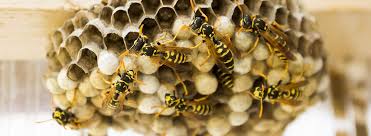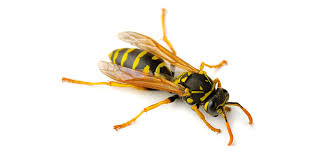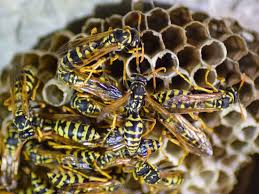How NOT to remove a wasp nest
There are many sources online advising on the best DIY methods to remove a wasp nest. Wasps are aggressive creatures and require little to no aggravation to attack, so trying to remove a wasp nest yourself can cost you both financially and physically.
DIY wasp nest removal is Not advised!
1. Burning a wasp nest
Using fire to remove a wasp nest is a very dangerous task and is not a successful way to eradicate the wasps.
Wasp nests are made from a thin papery substance produced by chewing wood into a pulp, making it extremely flammable. Because of this, burning a wasp nest can often lead to not only your property catching fire, but also you suffering painful burns.
Another problem with burning a wasp nest is that it is not an effective way to control a wasp problem. This is because it doesn’t kill all the wasps. It can lead to the remaining wasps in the nest becoming violent, as well as the wasps out foraging for food, resulting in them attacking you and any bystanders.
2. Water
Using water is often regarded as another way to get rid of a wasp nest. The truth is that flooding a wasps nest isn’t an effective method at all. This is because:
Depending on the location of the nest, using water to remove a wasp nest can result in further damages to your property. For example, if the wasp nest is your attic, trying to remove a wasp nest by flooding it could cause water damage to your attic beams and ceiling plaster boards.
Trying to flood a nest won’t get rid of all the wasps inhabiting the hive either. Similar to the effects of trying to burn a wasp nest, the wasps will become vicious and begin to attack, leaving you with a handful of painful stings.
3. Destroying a wasp nest with a baseball bat
Destroying a wasp nest with a bat, racket or any other item is another talked about removal option. To be honest, this is the least intelligent idea for removing a wasp nest yourself.
Trying to remove a wasp nest by destroying it with a baseball bat will put you at direct risk of getting stung, not only once but multiple times. This can be particularly dangerous if you are allergic to wasp stings as you could go into anaphylactic shock.
This method of DIY wasp nest removal puts you in close proximity to the hive, which is often enough aggravate them to trigger an attack. Trying to remove a wasp nest using a baseball bat can often result in being stung before the task has started.

How to get rid of a wasp nest without getting stung
If you have professional experience with disposing of active wasp nests, you may use one or more of the following methods. If not, the Fantastic Services team recommends that you leave this job to the professionals.
- With pesticide spray. You can purchase a wasp killing pesticide from your local supermarket. Follow the instructions on the can. The most common practice is to spray the pesticide in the opening of the nest for about 20 seconds. That is all. If the nest is active on the next day, repeat the process. Once all wasps are dead, you can knock down the nest.
- With insecticidal dust. If you’re dealing with a ground nest, insecticidal dust can prove useful. Just apply the dust on the nest liberally and then, vacate the area. Give it up to two days to work. If the nest is still active, repeat the process.
- With smoke. If you have a nest on a tree branch or somewhere away from your house, you can also try lighting a fire under it. The smoke will rise and suffocate the wasps, forcing them to leave it. Once they’re gone, you can knock down the nest.
- By dunking the nest in water. This one is effective but dangerous, and it’s only useful for aerial nests. First, place a bucket of water under the wasp nest. Then, carefully put the entire nest into a cloth bag. Make sure the bag has no holes or tears. Then, tightly secure the top of the bag with a firm string. Now, you can safely cut the nest from the branch and then, dunk it in the bucket. Place something heavy on top of the bucket and leave it overnight. The wasps should be dead by morning.

How long do wasps live?
Wasps are one of the most common stinging insects that pop up around spring and the summer time each year. These pesky bugs can cause a lot of pain, both physically and mentally for homeowners. So, how long do wasps live?
The lifecycle of a wasp depends on the species, but in general a worker wasps life can last from 12-22 days, while a queen can live up to a year. There are many different types of wasps in North America, paper wasps and yellowjackets being the two most common.
Paper wasp lifecycle
When the queens are fertilized, they spend their winters in sheltered areas like underneath tree barks, or crevices found in homes or other buildings. The queen then selects their nesting area and builds it in the spring.
The eggs are laid down and then hatched into larvae. Paper wasp larvae will develop in stages before becoming an adult. Workers will help build the nest, feed the young, and protect the nest. When a paper wasp nest matures it can hold anywhere between 20-30 adults. The queen will stop laying eggs in the late summer and shortly after the colony will die off; which will make it around 3-4 months for workers and 10-12 months for queens.
Yellowjacket wasp lifecycle
Yellowjackets or Vespula vulgaris are also social insects, and are able to build their nests the size of a basketball. Yellowjackets share similar nesting habits to paper wasps, where the queen will find shelter in the winter and seek a nest in the spring.
However, because of the queen’s ability to store sperm, the queen is able to lay eggs throughout the summer, and will run out at the end of the season. Which makes the lifecycle of this type of queen wasp, anywhere from 10-12 months.
Wasps can die of loneliness
Wasps are very social creatures and will build many colonies based off how well they mate. Since the purpose of a wasps life is to mate and/or create offspring, unmated wasps will eventually die off. Any unmated wasp, male or female, will perish around late summer to early fall.

How to prevent a wasp nest
Being a wasp preventer is always a better choice than being a wasp killer, and there are a number of precautions you can take to stop wasps from building nests in your property:
- Shut your bins: Leaving bins open will attract wasps that are looking for some easy food. To keep wasps out of your bins always make sure the lid is put on properly and keep your bins away from the building if possible.
- Protect windows and doors: One of the easiest ways to prevent a wasp nest is to keep wasps out of your home. Keep your doors and windows shut where possible, or install fly screens to stop insects getting in while still keeping the property cool during hot weather.
- Search for wasp nests: When it comes to springtime, it is worthwhile checking any spots that are likely to house a wasp nest. If you check for these during the spring, then the wasp nest will be small, and wasp nest removal will be simple. At this time of year, they will be around the size of a golf ball.
Does the old queen die off?
A queen wasp survives for one year only. She is hatched in the autumn along with around 1500 of her sisters then once mated she hibernates through the winter months then emerges in the spring ready to build a brand new nest. Only a small proportion of hibernating queens survive winter.
Once she has started the nest and hatched a few worker wasps, she spends the rest of her life in the nest as an egg-laying machine. In late summer/early autumn as the nest comes to the end of its natural life, the queen lays special eggs which once again are new queens for the next year.
Do wasps return to the same site?
Wasps do not generally return to the same place year after year. However, some roofs are favoured for their position and habitat. Some people say to us “we get a wasp nest every year”. If you appear to get a wasp nest every year, take a look at your roof, is it exposed to the sun all day? Wasps love warm locations.
Does your roof have plenty of gaps for wasps to gain entry?
Is there plenty of old wood available near your home (fence panels, garden sheds) for the wasps to use as a nest-building material? Food supply and local water supply will also be a factor.